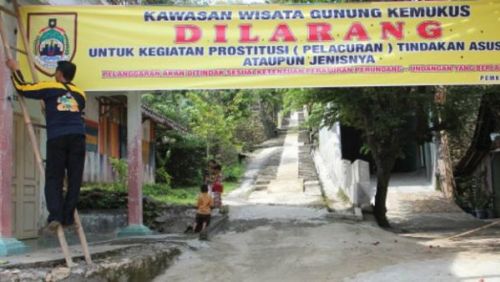Gunung Kemukus is a hilltop shrine located in Sragen, Central Java, but if you have followed news about Indonesia for the past few years, you might have heard it referred to by a different name: “Sex Mountain”.
The sex-seeking rituals of Gunung Kemukus were little known outside of Java until around 2012, when articles in the Western press such as Aubrey Belford’s seminal “Swingers’ Guide to Islam” exposed the shrine’s salacious secrets to the world. Since then, numerous features and documentaries have also investigated “Sex Mountain,” often focusing on how the shrine’s existence could be reconciled with Indonesia’s conservative brand of Islam.
While the rituals of Gunung Kemukus had been going on since the late 19th century and were generally tolerated (in part because it brought a great deal of tourist money to the local economy), Western reports such as a 2014 feature on “Sex Mountain” broadcast on SBS One in Australia (which you can watch above) scandalized local authorities.
In that same year, the governor of Central Java, Ganjar Pranowo, issued a ban on the tradition, saying it was a threat to morality and health (due to the high incident levels of STDs in the area). Part of the ban prevented locals from renting rooms to the shrines’ pilgrims, causing a sharp downturn in the local economy.
But despite the ritual’s official prohibition and sustained efforts to shut down the sex industry, the pilgrims and prostitution eventually started returning to Gunung Kemukus.
Recently, the regent of Sragen, Kusdinar Untung Yuni Sukowati, promised to completely rid the area around the shrine of prostitution by the end of the year (likely due to another recent spate of foreign media stories), leading to an intensification of civil service police (Satpol PP) raids on illegal karaoke bars and stalls that are usually set up for pilgrims looking for “partners” to engage in the mountain’s ritual with them (many of which were located in buildings that had been shut down in a previous crackdown one year ago).
“Later, all buildings that have become illegal karaoke bars and stalls in Kemukus will be torn down. After that, Kemukus will be reorganized into a religious tourism area, free from the negative practices that have been attached to it,” Kusdinar said Friday as quoted by Joglosemar.co.
Technically speaking, Gunung Kemukus was already a religious tourism site. The shrine itself was built to honor an ancient Javanese prince, Pangeran Samodro. The story goes that Samodro ran away with his stepmother and lover, Nyai Ontrowulan, and lived happily where the shrine now stands until they were stoned to death for their sins. From there, a local ritual emerged from the legend with the premise that doing immoral activities at the shrine could actually lead to good luck and guarantee success in ventures such as opening a new business. It combines elements of Javanese spirituality with Islamic, Hindu, and Buddhist beliefs.
The specifics of the ritual involve prayers and offerings at the shrine, ritualistic bathing at the shrines sacred spring and, crucially, having sex with somebody of the opposite sex who is not your spouse. Many believe that to get the shrine’s blessing, the ritual must be done seven times in a row every 35 days.

In the past few weeks, there have been numerous stories of illegal karaoke bars being raided and prostitutes being arrested as the government tries to put an end to the ritual. Banners throughout the area warn that prostitution and adultery in the area around Gunung Kemukus are forbidden. But no attempt at rebranding the shrine as a religious tourism site is likely to be successful as long as the social and economic reasons for “Sex Mountain” remain.





